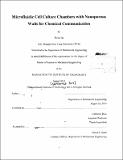| dc.contributor.advisor | Cullen R. Buie. | en_US |
| dc.contributor.author | Ge, Zhifei, Ph. D. Massachusetts Institute of Technology | en_US |
| dc.contributor.other | Massachusetts Institute of Technology. Department of Mechanical Engineering. | en_US |
| dc.date.accessioned | 2014-03-06T15:46:39Z | |
| dc.date.available | 2014-03-06T15:46:39Z | |
| dc.date.copyright | 2013 | en_US |
| dc.date.issued | 2013 | en_US |
| dc.identifier.uri | http://hdl.handle.net/1721.1/85502 | |
| dc.description | Thesis: S.M., Massachusetts Institute of Technology, Department of Mechanical Engineering, 2013. | en_US |
| dc.description | Cataloged from PDF version of thesis. | en_US |
| dc.description | Includes bibliographical references (pages 63-68). | en_US |
| dc.description.abstract | Reconstruction of phylogenetic trees based on 16S rRNA gene sequencing reveals that so far only a tiny fraction of microbial diversity has been cultured in the laboratory. One major reason behind this "unculturability" is that many microbes function in symbiosis, frequently exchanging metabolites to sustain their own metabolism, while key exchanged metabolites have hardly been identified. To advance the culturability of diverse microbes we propose a method to engineer a microfluidic co-culture platform, the Microfluidic Cell Culture Chambers, which mimics natural conditions for bacterial growth. The key innovation is to physically isolate bacteria while allowing chemical communication through metabolite diffusion. In this work, the device enables both high-throughput screening and real-time observation of bacterial growth. In our method, we use a porous material, poly(2-hydroxyethyl methacrylateco-ethylene dimethacrylate) (HEMA-EDMA), to fabricate a microwell array with 105 individual culture chambers. Pore size of HEMA-EDMA was confirmed by ESEM imaging to be less than 200 nm, adequate for isolating all identified bacteria. We have video-recorded fluorescence labeled Escherichia coli swimming in confined HEMA-EDMA wells and observed that E. coli is unable to travel between culture chambers. Single-strain E. coli is cultured with the device to test biocompatibility of the device. Syntrophic pairs of E. coli were constructed to test the devices' ability to culture inter-dependent species with physical isolation. In future work, culture of quorum sensing strains is suggested to look into inter-species chemical communication in the Microfluidic Cell Culture Chambers. The future device may be applied to recover uncultured microbial species from natural habitat. | en_US |
| dc.description.statementofresponsibility | by Zhifei Ge. | en_US |
| dc.format.extent | 68 pages | en_US |
| dc.language.iso | eng | en_US |
| dc.publisher | Massachusetts Institute of Technology | en_US |
| dc.rights | M.I.T. theses are protected by copyright. They may be viewed from this source for any purpose, but reproduction or distribution in any format is prohibited without written permission. See provided URL for inquiries about permission. | en_US |
| dc.rights.uri | http://dspace.mit.edu/handle/1721.1/7582 | en_US |
| dc.subject | Mechanical Engineering. | en_US |
| dc.title | Microfluidic cell culture chambers with nanoporous walls for chemical communication | en_US |
| dc.type | Thesis | en_US |
| dc.description.degree | S.M. | en_US |
| dc.contributor.department | Massachusetts Institute of Technology. Department of Mechanical Engineering | |
| dc.identifier.oclc | 871003444 | en_US |
